|
The pictures are arranged by Family. Return to
Native Plants page.
Press Release: "The Flower Mound, Flower Mound, Texas: A History
And Field Guide To The Flowers And Grasses “ Enters A Literary Land |
__________________________________________________________________________________________________
Wildflowers |
ACANTHACEAE -
Ruellia Family |

Prairie-petunia - Ruellia humilis
This perennial plant can be found in
prairies & open woods. It has
conspicuously hairy leaves & trumpet-shaped
flowers. |
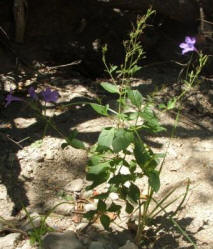
Violet ruellia - Ruellia
nudiflora
This plant can be found in near
streams & in woodlands. It grows very well in dappled light &
would be a perfect plant for shady, well-drained areas in your lawn
where other plants won't grow.
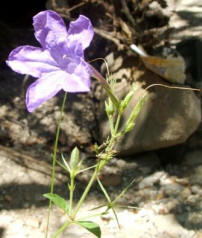 |
|
APIACEAE -
Parsley Family |
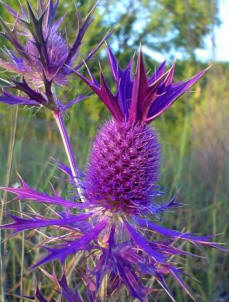
Leavenworth's
eryngo - Eryngium leavenworthii
Eryngo is striking in its color &
form. By late summer, the purple
extends down through the leaves & stem.
It can be found in prairies & "weedy" areas.
The dried plant looks nice in dried native
flower/grass arrangements. |
|
|
ASCLEPIADACEAE -
Milkweed Family |
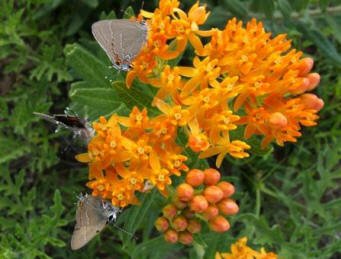
Butterfly milkweed with Northern Oak
Hairstreaks
-
Asclepias tuberosa
Butterflies love this milkweed.
It grows in open sandy prairies & stands erect. When growing
alongside a road, it easily demands your attention. |
|
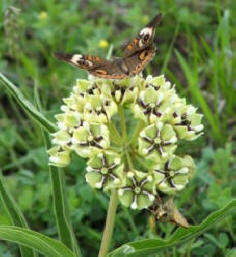
Antelope horn with Buckeye Butterfly
-
Asclepias asperula
Antelope horn is loved by many
species of butterflies & moths. It's a
perennial that reaches up to 2 feet in
height. It can often be seen in
overgrazed pastures & along roadsides.
The silky fluff from the seed was used in
making candle wicks in the past &
goldfinches use it to line their nests (in
their breeding range). |
ASTERACEAE - Sunflower
Family |
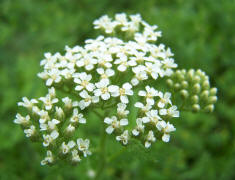
Western
yarrow - Achillea millefolium
Yarrow is a popular landscaping
plant sold in nurseries. Our native
yarrow has white blooms. This
perennial enjoys full sun or partial shade &
can grow up to 3 feet high. Its lacy,
fernlike leaves add a deep green color to
any garden. Yarrow has been used for
medicinal purposes because of its pungent
oil. It also looks good in dried
flower arrangements. |

Maximilian sunflower -
Helianthus maximiliani
Upright, tall perennial that can reach 10 feet in height. This is
a naturally dominant plant of the prairies, but has been reduced through
grazing. This tall sunflower would make a nice backdrop in
landscaping, while at the same time providing a food source for our
native birds!
|
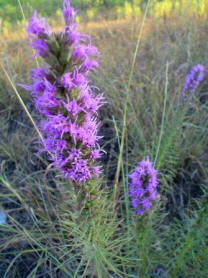
Narrowleaf gayfeather - Liatris
mucronata
Gayfeather is a late-summer blooming perennial that keeps brilliant
color in the landscape & your garden into the fall. Landscaping
varieties are sold in many nurseries. It grows well on poor
limestone & caliche soils. |

White rosinweed - Silphium
albiflorum
This beautiful, tough plant gets its name due to the sticky
secretions that cover the stems & leaves. It can be found in
calcareous soils & prairies throughout our region.
|
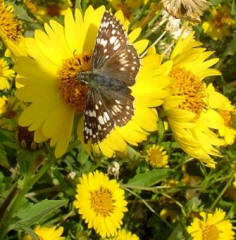
Cowpen daisy with Common Checkered
Skipper - Verbesina encelioides
This annual attracts multiple
species of butterflies. A stand in a corner of your yard or a
field will create an entire summer of butterfly-watching. It
reaches heights of 4 feet & is a prolific seeder. Native Americans
reportedly used Cowpen daisy in treating skin diseases. |
|
CAMPANULACEAE -
Bellflower Family |
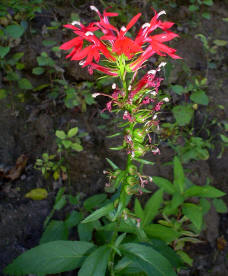
Cardinal-flower - Lobelia
cardinalis
This bright perennial grows 1-4' &
is found in moist areas such as along stream
banks. It makes a strong visual impact
with its stunning red flowers.
Cardinal-flower attracts hummingbirds with
its bright color. The plant makes good
background color in a garden.
|
|
|
COMMELINACEAE -
Dayflower Family |
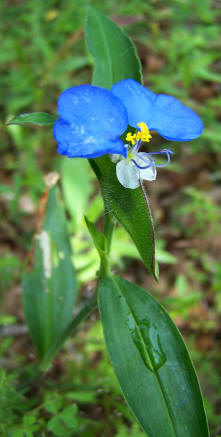
Widow's tears -
Commelina erecta
This interesting perennial is often
considered a weed in traditional lawns.
However, in the native landscaped yard, it
makes a fine border. The flowers open
in the morning & close in the evening.
If you squeeze the spathe, a drop of water
will emerge...hence its name. |
|
|
GENTIANACEAE -
Gentian Family |
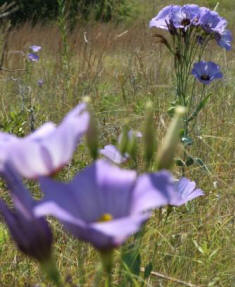
Texas
bluebells - Eustoma russellianum
This beautiful, upright annual by
itself would be enough to convince people to
save prairies. It prefers moist areas
in the open. The petals are generally
purple, but can sometimes be white or pink.
The flowers form a bouquet. But don't pick
them because it inhibits the plant's normal
propagation from seed.
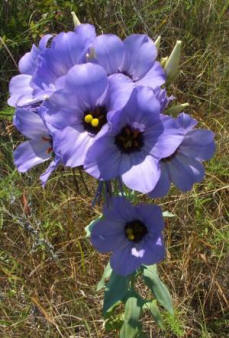
|
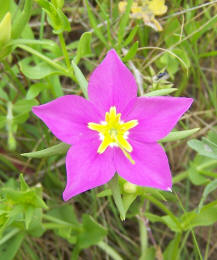
Meadow-pink - Sabatia
campestris
Meadow-pink is found in full sun in
moist soils & areas where rainwater collects. It is an annual that
can definitely add a bright splash of color to any yard or landscape. |
|
LAMIACEAE -
Mint Family |
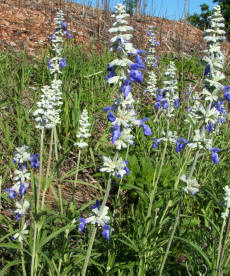
Mealy sage -
Salvia farinacea
This fast-growing perennial is
widely sold in the native plant industry.
It provides a clump of color with its whorls
of violet-blue flowers & its grayish green
foliage. It is seen in the natural
landscape growing on calcareous, rocky
soils. |
|
|
MALVACEAE -
Mallow Family |
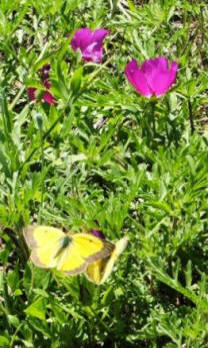
Wine-cup with Orange Sulphur Butterfly -
Callirhoe involucrata
This perennial is low & sprawling.
It makes a great groundcover or mass planting. It continues
flowering most of the summer. It overwinters as a small rosette of
leaves. They are typically found on sandy or gravelly prairies in
full sun.
|

Spreading
sida - Sida abutifolia
Found in lawns, on roadsides &
prairies, this woody perennial spreads &
hugs the ground. |
|
ONAGRACEAE -
Evening-Primrose Family |
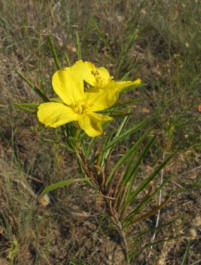
Square-bud
day-primrose - Calylophus
berlandieri
These delicate-looking flowers open
near sunrise or sunset. |
|
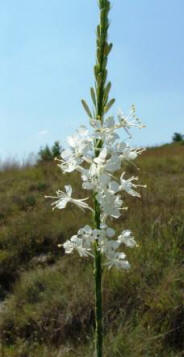
False gaura - Stenosiphon linifolius
This tall, upright perennial can
reach up to 9 feet tall! It grows on limestone soils & is an
excellent honey source for bees & other insects.
|
POLEMONIACEAE -
Phlox Family |
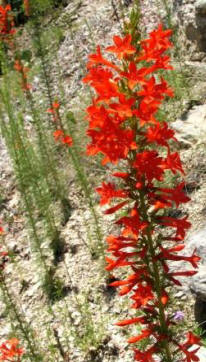
Standing cypress - Ipomopsis rubra
This is a striking wildflower that
demands your attention. The seeds are
easily raised in a garden setting from
fall-sown seeds. Because they can
reach 6 feet tall, they make a good
background planting in a garden.
Ruby-throated Hummingbirds help pollinate
these beautiful flowers. |
|
|
PORTULACACEAE -
Purslane Family |
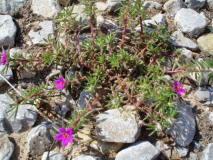
Shaggy portulaca - Portulaca
pilosa
Shaggy portulaca is a prostrate
succulent annual. It grows in sandy, gravelly areas in full sun.
The flowers open fully only in bright sun. Notice the white fluff
at the on the bottom stem - this is how it gets its common name "shaggy"
& species name pilosa.
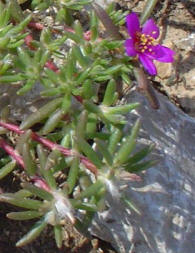
|
|
|
|
|
|
|
|
|
|
|
|
|
|
|
|
|
|
|
|
|
|
|
| This listing of native
plants of the Cross Timbers eco-region is not comprehensive. This
is merely a compilation of some plants that can be found locally in
lawns, parks, development sites, and natural areas. If you keep
your eyes to the ground, you'll be surprised at what you might find!
With water conservation in our urban areas
becoming increasingly more important, native plants in our landscapes
can help us save our precious water. Native plants grow naturally
in our soils, climate & unpredictable weather. They are
drought-tolerant and need little attention. Some of these native
plants may not be available in most local nurseries, however, you might
try calling nurseries that specialize in native plants. You always
have the option of propagating these plants from seed or vegetatively.
If nothing else, knowing some native plants will help you appreciate
their role in our environment and urban settings.
Some good resources for ID & to learn
more about native plants of Texas are:
Shinners & Mahler's Illustrated Flora of North Central Texas
by George M. Diggs, Jr., Barney L. Lipscomb,
& Robert J. O'Kennon
Wildflowers of Texas by Geyata Ajilvsgi
Wildflowers of the Texas Hill Country by Marshall Enquist
Texas Wildflowers by Campbell & Lynn Loughmiller
Trees of North Texas by Robert A. Vines
Trees of Texas by Carmine Stahl & Ria McElvaney
Grasses of the Texas Hill Country by Brian & Shirley
Loflin
Common Texas Grasses: An Illustrated Guide by Frank W.
Gould
Texas Wildscapes: Gardening for Wildlife by
Noreen Damude and Kelly Conrad Bender
Landscaping with Native
Plants of Texas by George Oxford Miller
How to Grow Native Plants of Texas & the Southwest by Jill
Nokes
Find out how community volunteers can take
an area that was formerly neglected and overgrown with invasive, exotic
privet and return the site to the Eastern Cross Timbers ecosystem.
Visit the Molly
Hollar Wildscape website to learn more.
Return to Native
Plants page.
|